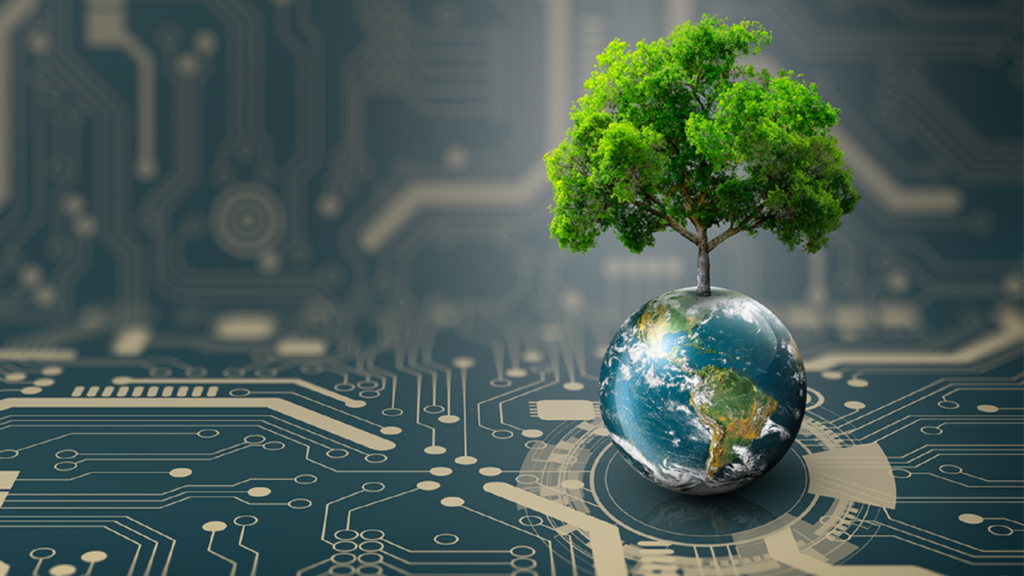The development of artificial intelligence, or AI, has undoubtedly aided in addressing the issue of climate change. With an increase in global temperatures and the prevalence of extreme weather events, AI brings forth solutions to mitigate the impact of climate change. From predictive modeling to the optimization of renewable energy resources, AI is revolutionizing the way humanity perceives and tackles environmental concerns. AI implementation in previously defined climate strategies leads to increased efficiency, diminished emissions, and more sustainable decision-making in different industries.
Using AI for Climate Data Analysis and Prediction
AI’s ability to process extensive, granular, and detailed segments of data makes it an ideal candidate to identify patterns, trends, and potential risks for climate change analysis. By analyzing past climate data, machine learning models can forecast future patterns, including weather patterns, heat waves, and rising sea levels. Different climate scenarios can be evaluated AI simulations, which helps scientists devise plans that reduce the associated risk. AI also monitors global temperatures, and atmospheric conditions, which allows policymakers to plan how to address climate catastrophes. AI enables researchers to build climate models to foresee intense weather conditions, making it easier for the community to be ready and respond effectively.
AI’s Role in Renewable Energy Optimization
Renewable energy adoption is arguably one of the most important measures to reduce greenhouse gas emissions, and AI is crucial to the optimal operation of solar, wind, and hydropower plants. Through machine learning and prediction algorithms, AI-enabled forecasting systems help predict energy production from renewable sources due to favorable weather conditions and other relevant factors, which can assist in greater use of green energy in electric grids. The use of smart grids allows the application of AI to the management of power supply for more efficient waste reduction and stable energy availability. Also, AI-powered energy storage management increases the reliability of renewables by determining the optimal charging and discharging times, ultimately aiding in the widespread adoption of clean energy.
Increasing Energy Efficiency Utilizing AI
With the help of AI, energy management systems are aiding in the decrease of carbon footprints for industries, businesses, and households alike, while optimizing energy usage. Smart AI building systems adjust the temperature, lighting, and electricity based on occupancy patterns, and skillfully manage heating and cooling of buildings. AI algorithms are optimizing industrial processes by spotting opportunities to save energy, which helps in minimizing emissions from factories or production facilities. AI-based home automation systems give instant feedback to consumers, allowing more sustainable energy decisions. AI enhances sustainability by contributing to decreased energy demand and carbon emissions.
AI in Carbon Capture and Emission Reduction Strategies
AI is transforming the efforts of carbon capture and sequestration with increased efficiency of carbon dioxide process emissions capture, storage, and use. Machine learning models analyze emission data to highlight high-pollution areas and recommend ways to reduce their carbon output. AI further helps in improving wasteful industrial processes’ carbon emissions reduction as well as the effectiveness of carbon capture technologies. Automated tracking systems enable businesses to monitor their carbon footprints by measuring emissions in real time. AI-powered solutions are being designed to not only change the captured carbon into safe compounds, but also give value using harmful emissions.
AI Solutions for Deforestation and Biodiversity Loss
Climate change is arguably the greatest challenge the world faces today. Through the use of AI, illegal logging and biodiversity loss can be monitored and protected. AI algorithms combined with satellite images help track deforestation in real-time. This allows authorities to take swift action against the abuse of natural resources. AI-powered drones are used to monitor forests and wildlife habitats. Such drones provide important ecosystem health indicators. AI algorithms assist in monitoring biodiversity by studying species populations and threats to conservation. AI has the potential to improve conservation efforts all over the world. AI-driven monitoring systems aim to reduce the most damaging forms of human activity, such as poaching and illegal mining, that threaten fragile ecosystems.
AI-Powered Solutions on Climate Change Resilience
Farming is one sector that will deeply suffer as a result of climate change, something AI technology is actively working to ameliorate. AI is assisting farmers in adjusting food production as well as adapting to changeable weather conditions. Predictive analytics on AI help farmers gain an understanding of soil health, check for crops’ diseases, and manage irrigation systems. Smart farming techniques powered by AI automate the processes of planting, harvesting, and fertilizing crops, which reduces waste and increases production. AI-powered climate models allow farmers to prepare for droughts, floods, and pest infestations, which protects the crops and helps farmers deal with some of the worst consequences of climate change. In the long run, AI-powered resilience technology would help increase food security and sustainability in agriculture in the context of climate change.
AI in Transportation for Environmental Sustainability
The climate crisis has been heavily accelerated by greenhouse gases, and one of the foremost reasons is the gas emissions from vehicles. AI has taken up the mantle of making transportation increasingly more eco-friendly. Congested streets often lead to wasted fuel, something that AI-optimized traffic management systems aim to fix. Electric and autonomous cars are also integrating AI to make vehicles more energy efficient and further cut down on emissions. Delivery services use AI for efficient route planning, which helps cut down on emissions. Public transport is no different, as AI also makes it possible to predict demand and alter schedules accordingly in order to minimize energy use. The amalgamation of all these technologies leads to reduced emissions and more eco-friendly urban areas.
AI’s Influence on Climate Finance and Green Investments
AI revolutionizes the financial market by facilitating investment into new green projects and spotting new economic developments. AI-enabled analysis assists investors in evaluating the environmental contribution of different companies, helping them make sustainable investments. Automated financial models pinpoint risks associated with climate change, enabling companies and government policymakers to formulate plans for sustainable development. AI-enabled climate risk evaluations allow underwriting companies to issue policies to businesses and other entities willing to adopt sustainable business practices. AI is employed by green finance institutions to connect investors with various projects aimed at improving the climate, thereby facilitating the transition to a low-carbon economy. AI helps align economic activities with ecological objectives, resulting in a sustainable economy.
Challenges and Ethical Considerations of AI in Climate Action
Despite AI providing advanced technologies to combat climate change, it also poses its own set of challenges and ethical issues. One major obstacle stems from the fact that AI is power-hungry as it demands extensive computing resources. If not properly managed, energy consumption can skyrocket. There must also be trust on the part of the technology companies whose accountability and transparency is needed to ensure that data privacy and security concerns are addressed, particularly in the climate monitoring systems that aggregate large amounts of data. Furthermore, artificial intelligence-based solutions to climate change must be made affordable to poor countries if the benefits are to be equally shared across the globe. Overcoming these obstacles is imperative if we are to effectively utilize AI in our efforts to minimize climate change.
The Future of AI and Climate Change Collaboration
The technological tie between AI and climate action is likely to get stronger due to advancement in technology. AI will improve the energy efficiency of systems, shift climate forecasts into the future, and speed up the adoption of renewable sources of energy. While governments and industries pour money into AI-based sustainability projects, there will be new developments in carbon capturing, conservation, and environmental monitoring. The implementation of climate policies worldwide will greatly benefit from the incorporation of AI and strategies aiming at the mitigation of carbon emissions and cessation of environmental degradation will be much more effective. If AI capabilities are used in a responsible manner, humanity will be able to shift toward a cleaner and greener future.
Conclusion
AI has been and continues to be a valuable partner in the fight against climate change, having provided ways of improving energy use and efficiency, resource use, and environmental monitoring. AI is enhancing sustainable development in almost all domains, from the management of renewable energy sources, through smart agriculture to climate finance. Still, some things like energy usage or data ethics have to be solved for AI to be useful without causing harm. It will be able to do more good as the technology evolves and its role in climate action will be more crucial than ever in creating a responsive and environmentally sustainable society.
FAQs
1. In which areas can AI be most useful in fighting climate change?
AI enhances climate predictions, optimizes the use of renewable resources, lowers pollutant emissions, and improves the environment.
2. Is AI capable of increasing the productivity of renewable energy sources?
Certainly, AI can forecast clean energy production, control smart grids, and advance energy storage systems, making it possible for renewable sources to be more beneficial.
3. What is the most troubling aspect of using AI technology to solve climate change problems?
The most troubling aspect could be the use of energy to power AI models, data or information privacy, and the assurance that AI-enabled solutions will be available to all regions, such as developing countries.
4. Does AI have the capability of single-handedly solving the problem of climate change?
AI is a powerful tool, but policies, education, and proactive sustainable measures must accompany it for effectively dealing with climate change.
5. What AI-related technologies can be utilized in agriculture to address climate change?
AI assists agriculture through climate forecasting, pest monitoring, irrigation management, and minimizing food loss, strengthening the response of agriculture to climate change.

